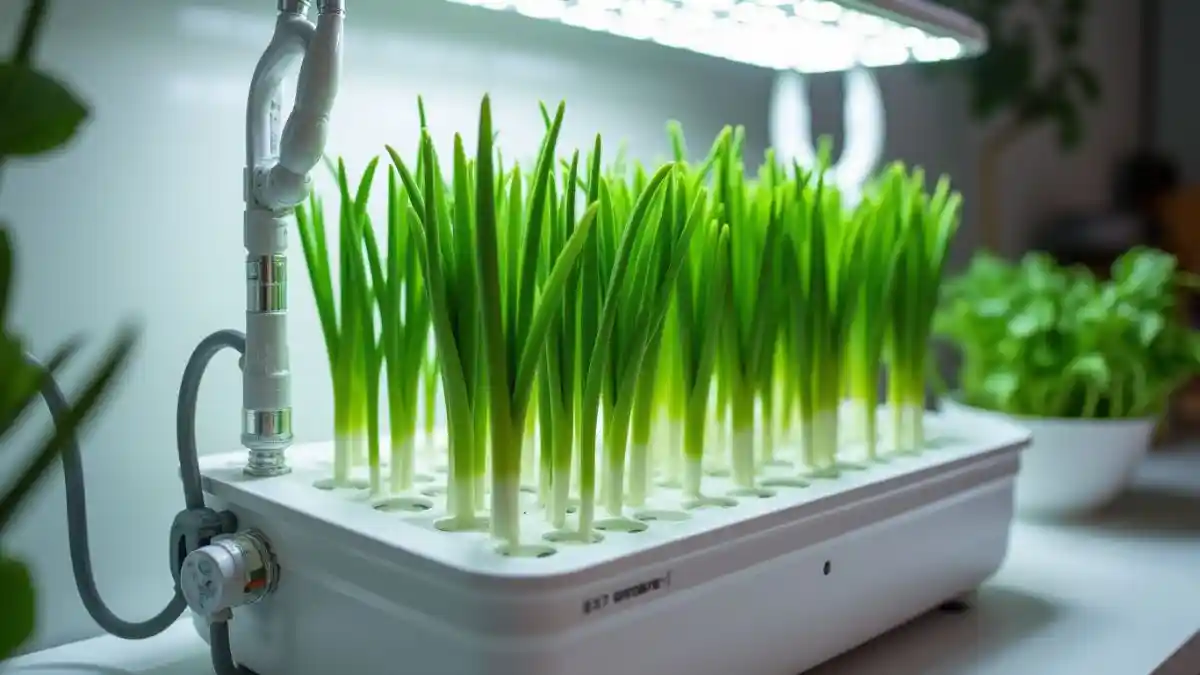If you’re looking to grow fresh, flavorful green onions at home, hydroponic gardening is the perfect solution. Whether you live in a tiny apartment or simply want to try something new, hydroponic green onions offer a simple, soil-free method that doesn’t require a lot of space or expertise. In this comprehensive guide, you’ll learn everything you need to know about growing green onions hydroponically, from choosing the right system to harvesting your crop.
Table of Contents
Why Hydroponic Green Onions Are Worth Trying
Imagine having fresh green onions on hand year-round without dealing with soil, weeds, or pest issues. Hydroponic green onions make it possible to enjoy these benefits. Hydroponic gardening is the practice of growing plants in a nutrient-rich water solution instead of soil. It’s an ideal choice for beginners who want to dive into gardening but lack outdoor space or have limited gardening knowledge.
Growing green onion hydroponics is straightforward and requires minimal maintenance. You can even grow these delicious veggies right in your kitchen or on your balcony. The best part? The growth cycle is quick, allowing you to enjoy your green onions in just a few weeks. Let’s dive into the steps that will help you get started on this easy and rewarding journey.
Step 1: Choosing the Best Hydroponic System for Green Onions
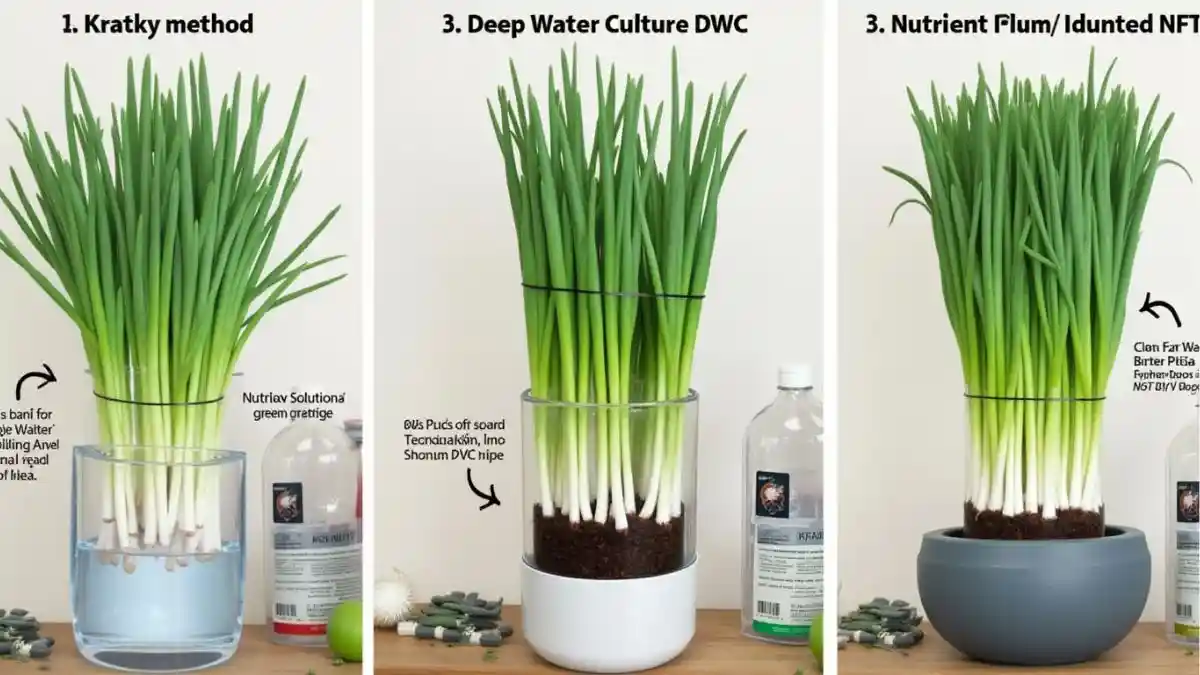
Before you start, it’s crucial to pick the right hydroponic system that suits your space and needs. While there are several options, some systems are particularly suited for growing green onions.
The Kratky Method (Best for Beginners)
If you’re just getting started, the Kratky method is one of the easiest systems to use. This passive hydroponic system doesn’t require a pump or electricity, making it a great option for those looking for simplicity. You only need a container, a nutrient solution, and your green onions. The plant roots grow directly into the water, and they can absorb nutrients without much intervention.
Deep Water Culture (DWC)
For faster growth, Deep Water Culture (DWC) might be the system for you. In DWC, plants are suspended above a nutrient-rich solution, and oxygen is constantly pumped to the roots to promote rapid growth. While this method may require a little more equipment (like a pump and air stone), it’s an excellent choice if you’re aiming for faster results.
Nutrient Film Technique (NFT)
If you’re looking to grow green onions in a larger scale or plan to expand your garden, the Nutrient Film Technique (NFT) may be a good fit. This system involves a thin film of nutrient solution flowing continuously over plant roots. It’s ideal for hydroponic green onions because it provides constant nourishment while preventing water stagnation.
Best Containers for Hydroponic Green Onions
The containers you use can greatly impact the growth of your green onions. You can use simple net pots, mason jars, or even PVC pipes, depending on the system you choose. Net pots, which are small mesh containers, work well in Kratky and DWC setups.
Step 2: Selecting and Preparing Green Onion Seeds or Cuttings
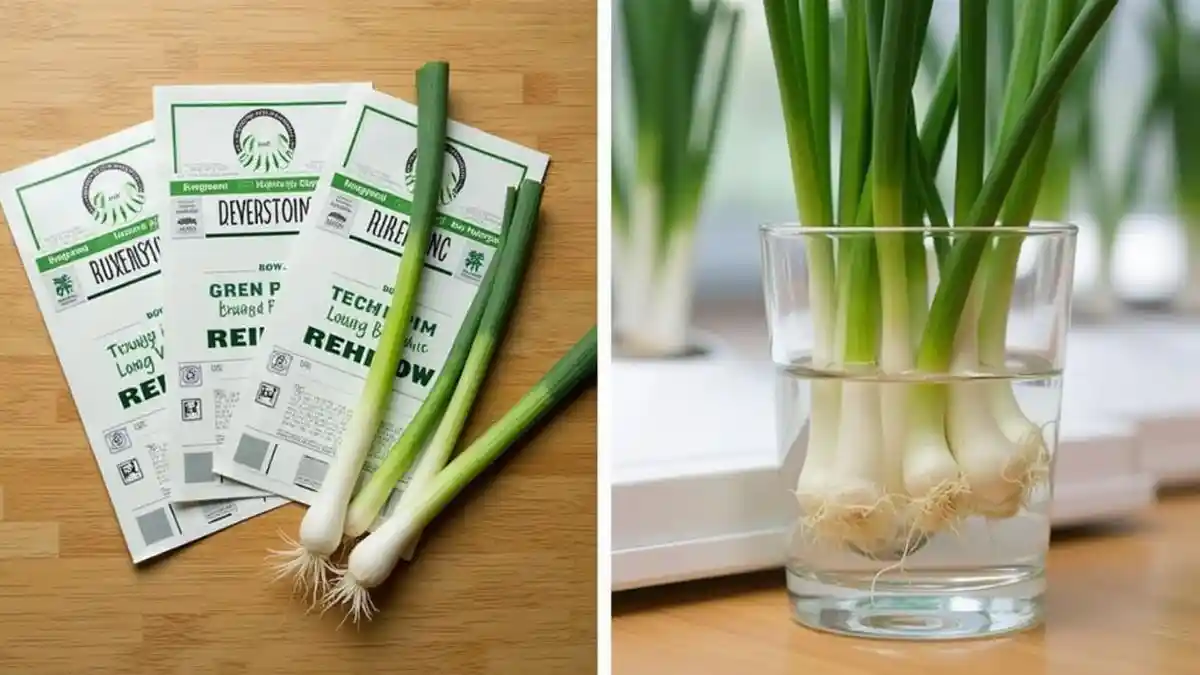
You can either grow green onions hydroponically from seeds or by regrowing from scraps. Here’s how you can prepare your green onions for hydroponic growth:
Best Green Onion Varieties for Hydroponics
While many varieties of green onions can thrive in hydroponics, here are a few popular options:
- Evergreen White Bunching: Known for its fast growth and mild flavor, this variety is perfect for hydroponic systems.
- Tokyo Long White: With a subtle flavor and long white stalks, it’s an excellent choice for hydroponic gardens.
- Red Baron: This variety offers a rich color and slightly spicier flavor, adding a unique touch to your dishes.
Regrowing Green Onions from Scraps
If you already have green onions at home, you can easily regrow them from the scraps. Here’s how:
- Cut off the green tops, leaving about 2 inches of the white base.
- Place the base in a glass of water, ensuring the roots stay submerged.
- After a few days, you will notice roots developing. Once they grow to about 1–2 inches, transfer them to your hydroponic system.
Regrowing green onions is one of the easiest and most rewarding methods to start your hydroponic garden.
Step 3: Setting Up the Perfect Nutrient Solution
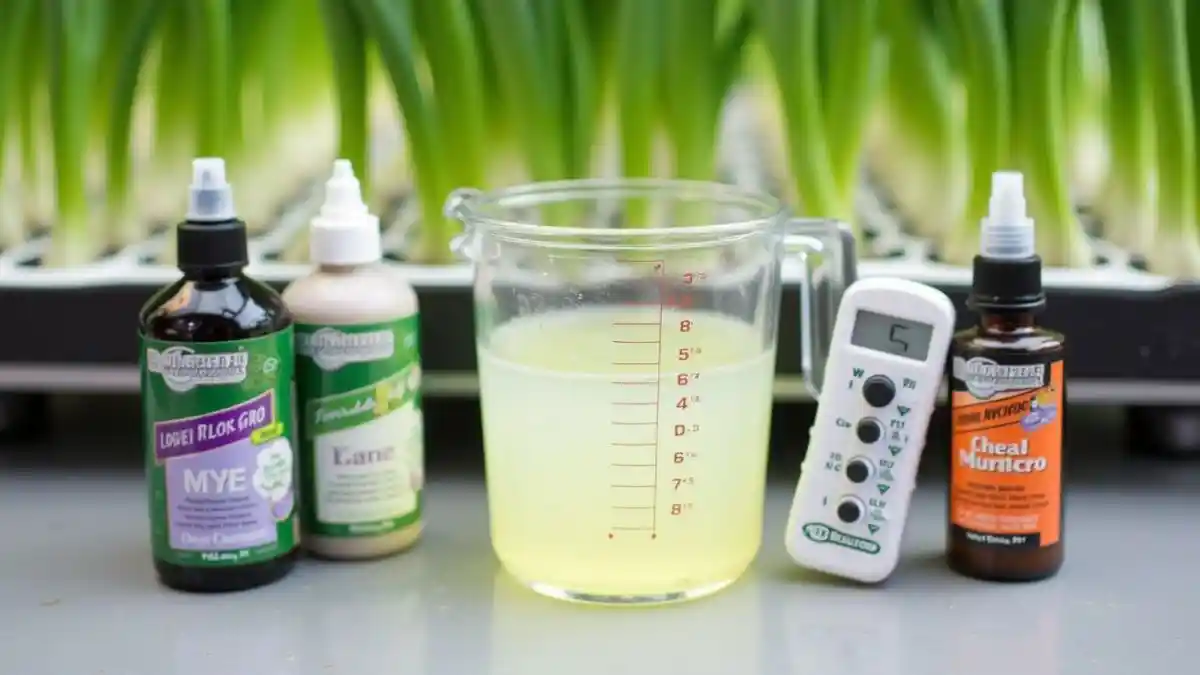
In hydroponics, nutrients are essential for plant health. The General Hydroponics feed chart provides the right balance of nutrients for your plants to thrive. Here’s how you can set up the perfect nutrient solution for your green onions:
Choosing the Right Nutrient Mix
Green onions require a balanced blend of Nitrogen (N), Phosphorus (P), and Potassium (K) for optimal growth. The General Hydroponics Flora Series is a great choice for beginners and provides all the essential nutrients your plants need.
- FloraGro: Rich in nitrogen, it supports leafy growth.
- FloraBloom: Provides phosphorus to strengthen roots and improve flowering.
- FloraMicro: Contains vital trace elements that help plants grow.
Make sure to follow the General Hydroponics feed chart for the correct amounts of each nutrient to add to your system. Always adjust the nutrient concentration based on the stage of growth of your green onions.
Maintaining pH and EC Levels
Your nutrient solution should have a pH level between 5.5 and 6.5 for optimal nutrient absorption. You can use a General Hydroponics pH control kit to adjust the pH if necessary.
Your nutrient solution’s Electrical Conductivity (EC) should be maintained between 1.0 and 1.5 mS/cm to ensure your plants get the right balance of nutrients without becoming overwhelmed.
Step 4: Providing Optimal Light and Temperature Conditions
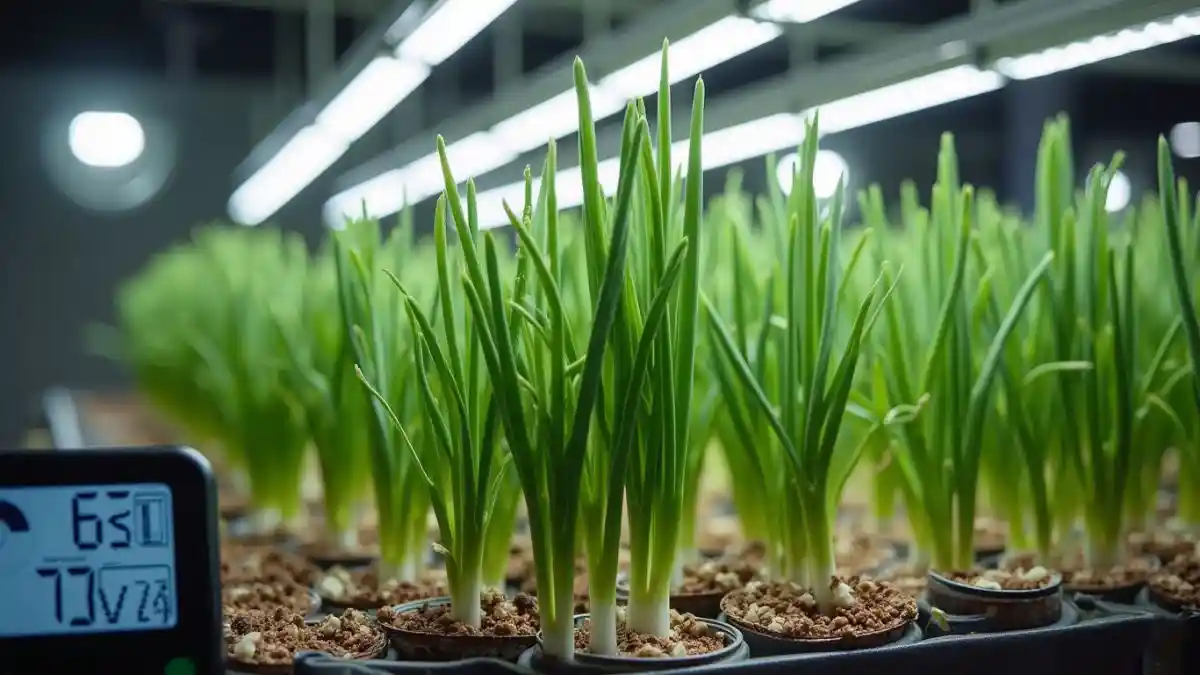
Light and temperature are crucial factors in growing hydroponic green onions successfully.
Best Grow Lights for Hydroponic Green Onions
Since you’re growing indoors, you’ll need to provide adequate lighting for your plants. Use full-spectrum LED grow lights for energy efficiency and optimal growth. These lights simulate sunlight, allowing your green onions to thrive indoors. Aim for at least 12–14 hours of light per day.
Ideal Temperature Range
Green onions grow best in temperatures between 65°F and 75°F (18°C to 24°C). If you live in a cooler climate, you might need to adjust your room temperature or use a small space heater.
Step 5: Maintaining and Monitoring Growth
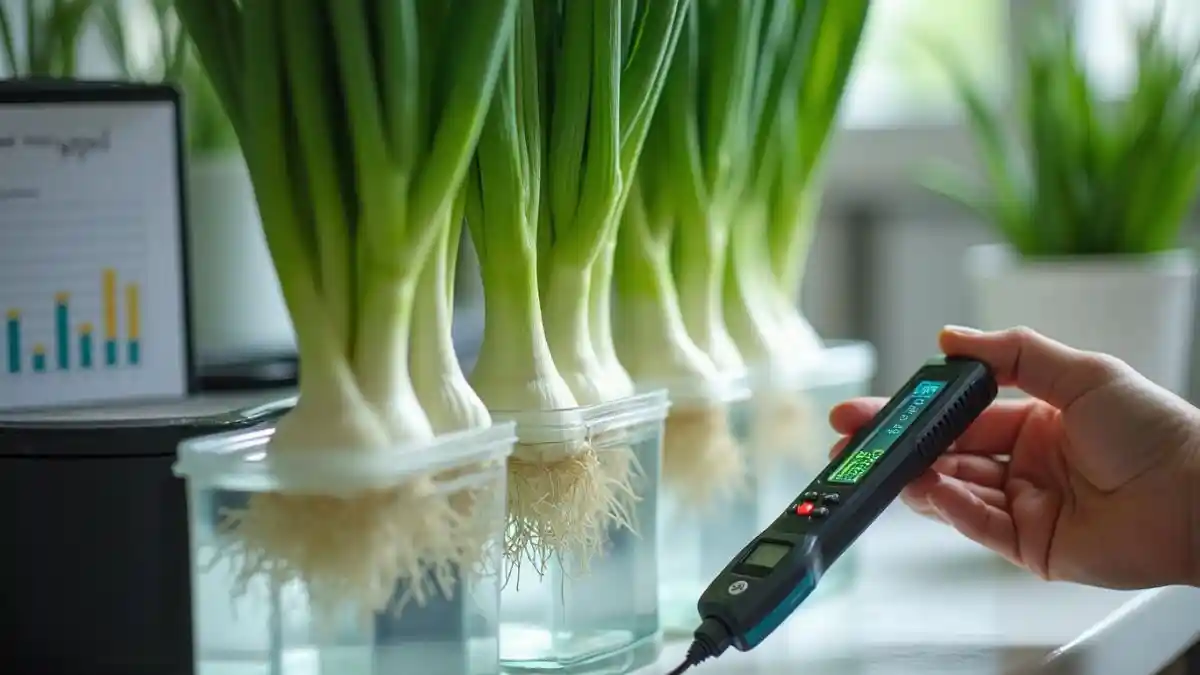
Once your hydroponic green onions are growing, you’ll need to monitor their health regularly.
Watering and Nutrient Adjustments
Ensure that your plants have consistent access to the nutrient solution. You should check the water level regularly and top it up when necessary. Depending on the system, the water may need to be changed every 1-2 weeks to prevent nutrient buildup or stagnation.
Preventing Common Issues
Hydroponic plants are less prone to pests, but you’ll still need to keep an eye out for common issues like algae growth and root rot. Keeping your system clean and well-maintained is the key to preventing these problems.
Step 6: Harvesting Hydroponic Green Onions
One of the great benefits of hydroponic green onions is that they grow quickly and are ready to harvest in as little as 2-3 weeks.
How to Harvest Your Green Onions
When your green onions reach a sufficient height, it’s time to harvest. Cut the green tops about 2 inches above the base to allow the plant to continue growing. Regular harvesting will encourage your green onions to produce new shoots, ensuring a continuous supply.
Step 7: Storing and Using Hydroponic Green Onions
Once harvested, you can store your hydroponic green onions in a few different ways.
Best Storage Methods
- Refrigeration: Wrap your green onions in a damp paper towel and place them in the fridge. They should last for about 1-2 weeks.
- Freezing: If you have a large harvest, chop your green onions and freeze them for future use. They can be stored in the freezer for 3-6 months.
Delicious Recipes to Try with Hydroponic Green Onions
Here are a few simple recipes that showcase the fresh, crisp flavor of hydroponic green onions:
- Scallion Pancakes: A quick, savory dish that’s perfect for any meal.
- Green Onion Butter: A flavorful spread for bread, potatoes, or grilled meats.
- Miso Soup: Add freshly chopped green onions for an extra burst of flavor.
FAQ: Hydroponic Green Onions
Q1: How long do hydroponic green onions take to grow?
A: Green onions typically take 2-3 weeks to grow from cuttings and 4-6 weeks from seeds.
Q2: Can I regrow green onions forever?
A: No, but you can regrow them 3-4 times before the quality starts to decline.
Q3: Do I need special equipment to grow hydroponic green onions?
A: While the Kratky method is simple and requires minimal equipment, you will need a container, nutrient solution, and possibly a grow light depending on your setup.
Q4: Can I use tap water for hydroponic green onions?
A: Yes, but it’s best to let tap water sit for 24 hours to remove chlorine before using it in your system.
Q5: What’s the best way to boost green onion growth?
A: Ensure they get 14 hours of light per day, maintain optimal pH and nutrient levels, and ensure proper aeration of the roots.
Conclusion
By following these simple steps, you’ll be on your way to growing fresh, delicious green onions hydroponically. Whether you’re a beginner or an experienced gardener, hydroponic green onions are an easy and rewarding addition to any garden. Ready to start your own hydroponic garden? The time is now—grow fresh green onions all year round and enjoy the convenience of having them right at your fingertips!
Let us know how your hydroponic green onion garden is growing—leave a comment below or share your tips with the community!


